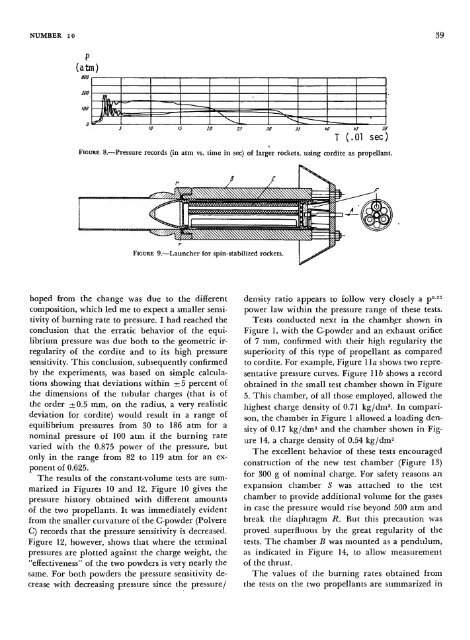FIRST STEPS TOWARD SPACE - Smithsonian Institution Libraries
FIRST STEPS TOWARD SPACE - Smithsonian Institution Libraries
FIRST STEPS TOWARD SPACE - Smithsonian Institution Libraries
Create successful ePaper yourself
Turn your PDF publications into a flip-book with our unique Google optimized e-Paper software.
NUMBER 10 39<br />
P<br />
(atm)<br />
3 J<br />
/ (In,.,<br />
Hvv/"<br />
WM ' = = a -- ^<br />
tf /.J /^ ?^ JP «<br />
-<br />
'<br />
T (.01 sec)<br />
FIGURE 8.—Pressure records (in atm vs. time in sec) of larger rockets, using cordite as propellant.<br />
FIGURE 9.—Launcher for spin-stabilized rockets<br />
hoped from the change was due to the different<br />
composition, which led me to expect a smaller sensitivity<br />
of burning rate to pressure. I had reached the<br />
conclusion that the erratic behavior of the equilibrium<br />
pressure was due both to the geometric irregularity<br />
of the cordite and to its high pressure<br />
sensitivity. This conclusion, subsequently confirmed<br />
by the experiments, was based on simple calculations<br />
showing that deviations within ±5 percent of<br />
the dimensions of the tubular charges (that is of<br />
the order ±0.5 mm, on the radius, a very realistic<br />
deviation for cordite) would result in a range of<br />
equilibrium pressures from 30 to 186 atm for a<br />
nominal pressure of 100 atm if the burning rate<br />
varied with the 0.875 power of the pressure, but<br />
only in the range from 82 to 119 atm for an exponent<br />
of 0.625.<br />
The results of the constant-volume tests are summarized<br />
in Figures 10 and 12. Figure 10 gives the<br />
pressure history obtained with different amounts<br />
of the two propellants. It was immediately evident<br />
from the smaller curvature of the C-powder (Polvere<br />
C) records that the pressure sensitivity is decreased.<br />
Figure 12, however, shows that where the terminal<br />
pressures are plotted against the charge weight, the<br />
"effectiveness" of the two powders is very nearly the<br />
same. For both powders the pressure sensitivity decrease<br />
with decreasing pressure since the pressure/<br />
density ratio appears to follow very closely a p 0 - 25<br />
power law within the pressure range of these tests.<br />
Tests conducted next in the chamber shown in<br />
Figure 1, with the C-powder and an exhaust orifice<br />
of 7 mm, confirmed with their high regularity the<br />
superiority of this type of propellant as compared<br />
to cordite. For example, Figure 11a shows two representative<br />
pressure curves. Figure 116 shows a record<br />
obtained in the small test chamber shown in Figure<br />
5. This chamber, of all those employed, allowed the<br />
highest charge density of 0.71 kg/dm 3 . In comparison,<br />
the chamber in Figure 1 allowed a loading density<br />
of 0.17 kg/dm 3 and the chamber shown in Figure<br />
14, a charge density of 0.54 kg/dm 3<br />
The excellent behavior of these tests encouraged<br />
construction of the new test chamber (Figure 13)<br />
for 300 g of nominal charge. For safety reasons an<br />
expansion chamber 5 was attached to the test<br />
chamber to provide additional volume for the gases<br />
in case the pressure would rise beyond 500 atm and<br />
break the diaphragm R. But this precaution was<br />
proved superfluous by the great regularity of the<br />
tests. The chamber B was mounted as a pendulum,<br />
as indicated in Figure 14, to allow measurement<br />
of the thrust.<br />
The values of the burning rates obtained from<br />
the tests on the two propellants are summarized in

















